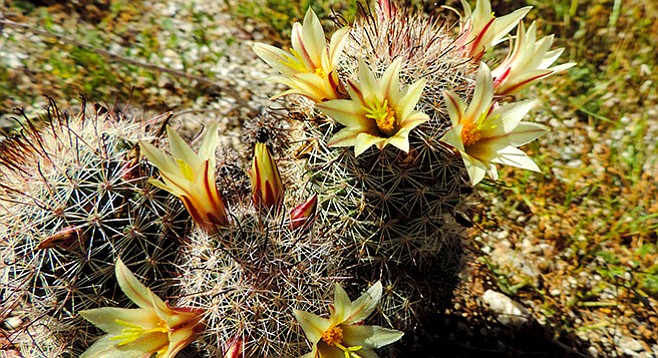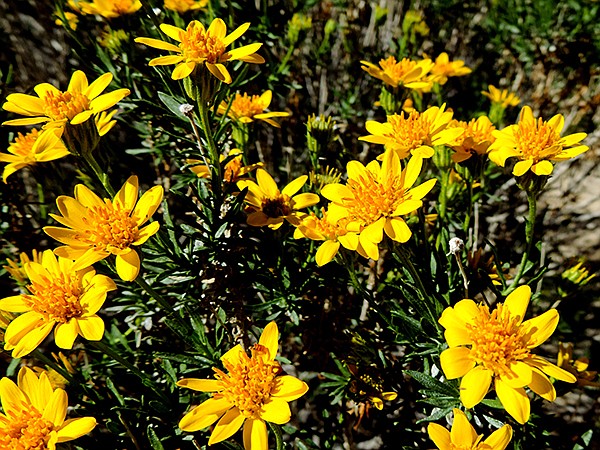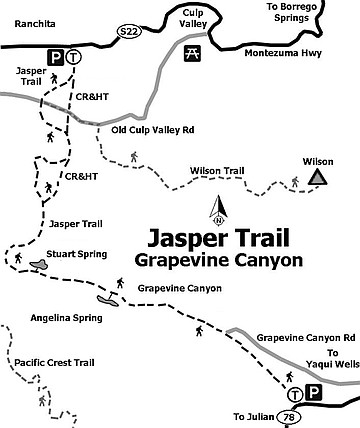 Facebook
Facebook
 X
X
 Instagram
Instagram
 TikTok
TikTok
 Youtube
Youtube


The name of this hike hints at the history found here. The Jasper Trail is named after Ranchita cattleman Ralph Jasper, who, at one time, owned over 5500 acres in portions of Montezuma Valley, Grapevine Canyon, and Yaqui Well, much of which is part of Anza-Borrego Desert State Park (ABDSP) today. Ralph Jasper developed both Stuart and Angelina springs to make watering holes for his cattle. His father James Jasper, a San Diego County supervisor, had initially homesteaded in Grapevine Canyon, where he had found wild grapes near springs and in the canyon.
This hike begins in the San Ysidro Mountains near the small community of Ranchita and descends 12 miles down the scenic Jasper Trail into Grapevine Canyon, ending at the junction of Grapevine Canyon Road and SR-78 at Yaqui Flat where Sentenac Canyon opens up to the desert. Ralph Jasper used this trail when moving cattle from his ranch in Ranchita down to the warmer climes of Anza-Borrego for the winter.
It is recommended that this hike be done with a shuttle by leaving a car at the terminus on SR-78 at the Plum Canyon trailhead, and then driving 23 miles back to the start of the hike on Jasper Trail off of S-22. This direction makes for a mostly downhill trek, but there will still be sections requiring some gain in altitude before dropping down. The length of the hike can be modified by how far one drives down Jasper Trail before parking and heading out on foot. All distances listed here are assuming that the hike begins at the top of Jasper Trail.
The first part of the trail is in a relatively flat open area that was burned in the 2013 Ranchita Fire. Expect showy displays of wildflowers for the next several years as the transition zone vegetation recovers. In season, abundant stands of common phacelia cover the ground. Look for pale lavender flowers arranged in a coil, looking much like the body of a curled caterpillar. You may also find tall yellow mounds of small sunflower-like blooms of interior goldenbush. Even when not in bloom, be sure to take time to smell the strongly lemon-scented leaves.

Approximately one mile from S-22, the California Riding and Hiking Trail cuts south off of Jasper Trail and provides escape from motorized activity. You may follow this single-track path through stands of scrub oak and California juniper. The juniper was used by Native Americans in infusions, decoctions, and poultices to cure a number of ailments. While on the CRHT, you will cross Old Culp Valley Road and rejoin Jasper Trail for a short distance before returning to the CRHT. At 3.5 miles, you will once again rejoin the Jasper Trail and meander up and down the rugged dirt road until finally coming to Grapevine Canyon at 5 miles. The canyon is a sandy trail that runs between the San Felipe Hills and Grapevine Hills, also named after the growth of wild grapes that were found on the canyon floor.
Heading east, you quickly come to Stuart Spring, the only reliable source of water for many miles, frequented by animals and insects. With a little hunting it is possible to locate a small water-filled trough constructed by Ralph Jasper; however, be sure to filter the water if taken from the spring.

This is one of the few areas where two species of quail are known to inhabit the Anza-Borrego. There are subtle distinctions between the two. Gambel’s quail have a redder head than the bluer-headed California quail, while the California quail has a much more distinct scale pattern on its chest, compared to the Gambel’s. In addition, the Gambel’s has a cream-colored belly, with the male having a black patch on its belly. Typical of quail, both prefer to walk rather than fly, so look on the ground but keep an eye out for a lone male standing on a high point keeping a lookout for danger.
Angelina Springs is next at 6.8 miles, where the water is subsurface much of the year, identified by lush stands of willow and pink-flowered arrow weed, so named for its long, straight stems used by the native people in fashioning the shafts of arrows. This area was inhabited by native peoples for 5000 years, first by an archaic Indian group and later by Kumeyaay Indians, and is now one of seven cultural reserves in the Anza-Borrego.
Follow Grapevine Canyon Road through ocotillo, agave, yucca, barrel cactus, and teddy-bear cholla and displays of desert wildflowers during spring. At mile 9.9 there is a signed fork in the road. Left goes to the north side of Yaqui Flat and toward Yaqui Well. Keep right for SR-78 and a return to your shuttle car parked at Plum Canyon.
This route is a popular 4WD route on weekends, but mid-week there may be little or no traffic. No matter the day, you will discover great views, incredible solitude, and a rewarding trip through some of Anza-Borrego’s less-visited landscapes.
Distance from downtown San Diego: About 75 miles. Allow 1.5 hours driving time (Ranchita). Drive to Santa Ysabel and go north on SR-79. Drive 11.5 miles and turn right (east) onto San Felipe Rd. (S-2). Drive 4.7 miles on S-2 and then turn left (east) onto Montezuma Rd. (S-22). Go 6.8 miles on S-22 to the Jasper Truck Trail on right (south).
Hiking length: 12 miles one way.
Difficulty: Difficult. Less than 500 feet of elevation gain with an elevation loss of about 2500 feet. Hikers, bicycles, horses, motorized vehicles, and dogs (on leashes) are allowed. No facilities.



The name of this hike hints at the history found here. The Jasper Trail is named after Ranchita cattleman Ralph Jasper, who, at one time, owned over 5500 acres in portions of Montezuma Valley, Grapevine Canyon, and Yaqui Well, much of which is part of Anza-Borrego Desert State Park (ABDSP) today. Ralph Jasper developed both Stuart and Angelina springs to make watering holes for his cattle. His father James Jasper, a San Diego County supervisor, had initially homesteaded in Grapevine Canyon, where he had found wild grapes near springs and in the canyon.
This hike begins in the San Ysidro Mountains near the small community of Ranchita and descends 12 miles down the scenic Jasper Trail into Grapevine Canyon, ending at the junction of Grapevine Canyon Road and SR-78 at Yaqui Flat where Sentenac Canyon opens up to the desert. Ralph Jasper used this trail when moving cattle from his ranch in Ranchita down to the warmer climes of Anza-Borrego for the winter.
It is recommended that this hike be done with a shuttle by leaving a car at the terminus on SR-78 at the Plum Canyon trailhead, and then driving 23 miles back to the start of the hike on Jasper Trail off of S-22. This direction makes for a mostly downhill trek, but there will still be sections requiring some gain in altitude before dropping down. The length of the hike can be modified by how far one drives down Jasper Trail before parking and heading out on foot. All distances listed here are assuming that the hike begins at the top of Jasper Trail.
The first part of the trail is in a relatively flat open area that was burned in the 2013 Ranchita Fire. Expect showy displays of wildflowers for the next several years as the transition zone vegetation recovers. In season, abundant stands of common phacelia cover the ground. Look for pale lavender flowers arranged in a coil, looking much like the body of a curled caterpillar. You may also find tall yellow mounds of small sunflower-like blooms of interior goldenbush. Even when not in bloom, be sure to take time to smell the strongly lemon-scented leaves.

Approximately one mile from S-22, the California Riding and Hiking Trail cuts south off of Jasper Trail and provides escape from motorized activity. You may follow this single-track path through stands of scrub oak and California juniper. The juniper was used by Native Americans in infusions, decoctions, and poultices to cure a number of ailments. While on the CRHT, you will cross Old Culp Valley Road and rejoin Jasper Trail for a short distance before returning to the CRHT. At 3.5 miles, you will once again rejoin the Jasper Trail and meander up and down the rugged dirt road until finally coming to Grapevine Canyon at 5 miles. The canyon is a sandy trail that runs between the San Felipe Hills and Grapevine Hills, also named after the growth of wild grapes that were found on the canyon floor.
Heading east, you quickly come to Stuart Spring, the only reliable source of water for many miles, frequented by animals and insects. With a little hunting it is possible to locate a small water-filled trough constructed by Ralph Jasper; however, be sure to filter the water if taken from the spring.

This is one of the few areas where two species of quail are known to inhabit the Anza-Borrego. There are subtle distinctions between the two. Gambel’s quail have a redder head than the bluer-headed California quail, while the California quail has a much more distinct scale pattern on its chest, compared to the Gambel’s. In addition, the Gambel’s has a cream-colored belly, with the male having a black patch on its belly. Typical of quail, both prefer to walk rather than fly, so look on the ground but keep an eye out for a lone male standing on a high point keeping a lookout for danger.
Angelina Springs is next at 6.8 miles, where the water is subsurface much of the year, identified by lush stands of willow and pink-flowered arrow weed, so named for its long, straight stems used by the native people in fashioning the shafts of arrows. This area was inhabited by native peoples for 5000 years, first by an archaic Indian group and later by Kumeyaay Indians, and is now one of seven cultural reserves in the Anza-Borrego.
Follow Grapevine Canyon Road through ocotillo, agave, yucca, barrel cactus, and teddy-bear cholla and displays of desert wildflowers during spring. At mile 9.9 there is a signed fork in the road. Left goes to the north side of Yaqui Flat and toward Yaqui Well. Keep right for SR-78 and a return to your shuttle car parked at Plum Canyon.
This route is a popular 4WD route on weekends, but mid-week there may be little or no traffic. No matter the day, you will discover great views, incredible solitude, and a rewarding trip through some of Anza-Borrego’s less-visited landscapes.
Distance from downtown San Diego: About 75 miles. Allow 1.5 hours driving time (Ranchita). Drive to Santa Ysabel and go north on SR-79. Drive 11.5 miles and turn right (east) onto San Felipe Rd. (S-2). Drive 4.7 miles on S-2 and then turn left (east) onto Montezuma Rd. (S-22). Go 6.8 miles on S-22 to the Jasper Truck Trail on right (south).
Hiking length: 12 miles one way.
Difficulty: Difficult. Less than 500 feet of elevation gain with an elevation loss of about 2500 feet. Hikers, bicycles, horses, motorized vehicles, and dogs (on leashes) are allowed. No facilities.